
Into the multiverse: predicting lab outcomes with Binocs ‘what-if’ scenario analysis
In the third installment of this series investigating the role of project management techniques in Binocs, Adam Lester-George explores what-if scenario analyses (WISA) and how they can be used to help predict outcomes and mitigate risk in pharma capacity planning.
Into the planning multiverse
Many worlds lay before you
Imagine that you are on an extended lunch break and decide to step out of the lab for a while to take a walk in the fresh air. You wander for a time, dwelling on your work and distracted by the challenges that lay ahead when you suddenly realize that you have strayed onto an unfamiliar path. You look behind you but the route you have just traveled is blocked; in front of you is a fork in the road with no sign and no indication of what awaits along either route. If you wish to continue moving forward and return to civilization, you must choose to take the left path or the right.
Uncertainty and risk
You have no way of knowing what lays down either path and, as such, your perception of the risk associated with either option must be equal – assuming that there is an optimal path, whichever direction you choose presents a 50% chance of being the better option and a 50% chance of being the worse option. While the overall risk is unknown, the relative risk of either choice is equal. Since the choice is effectively arbitrary, you toss a coin to decide; it lands on heads, and so you continue your journey along the left path, hoping you will find your way back to the lab.
Almost immediately, you fall down a deep hole.
As you languish at the bottom of your lonely dark pit, you reflect on what you know: moments earlier, you had a 50% chance of picking the “better” route but, right now, you have a 100% chance of being stuck in a hole. How do you know whether you picked the “worse” option? Sure, the other path could have led you on an easy route directly back to your workplace or maybe a pot of gold, but it’s also possible that it would have guided you directly into a lava flow or the den of an angry bear! Given your current predicament, you can’t help but ask “what if the coin toss had led me down the righthand path?”.
Infinite choice
Well, according to one interpretation of “multiverse” theory, each decision you make causes reality to split and branch along the direction of each of your different potential choices. When you arrive at the fork in the road and select the left path, one universe exists in which you go on to take that left path and, as a result, fall down the hole. However, another entirely separate universe also exists in which the coin lands on tails, that universe’s version of you turns right and ends up back at work, enjoying a coffee in the cafeteria and idly wondering what would have happened if you’d picked the other path.

Managing uncertainty
Probabilism vs determinism
In a multiverse, there is a non-zero probability that you will end up in one of the branching universes created by your choice, but it is 100% certain that a version of you will be present on each of those branches. To an observer who exists outside of space and time, a random event (a coin toss) results in multiple definite situations; in other words, a probabilistic situation has multiple wholly deterministic outcomes.
When confronted with a choice about how to plan a project, wouldn’t it be incredibly useful to consult with all the possible future yous to determine all the possible outcomes and make it an informed choice?
Project management perspective
In our previous explorations of project management methodologies, we looked at developing a critical chain to optimize planning and how to present that optimally-planned project with Gantt charts, so hopefully, your project plan is reasonably robust. Fortunately, unlike our hypothetical fork in the road, a well-planned project won’t be full of blind alleys and unknown paths – the destination is known and the direction of travel is clear. Nevertheless, projects are full of uncertainty, and a good project plan should be flexible enough to accommodate the unknown.
What-if scenario analysis
This is where a what-if scenario analysis (WISA) can be critically important. According to the Seventh Edition of the Project Management Institute’s A Guide to the Project Management Body of Knowledge (PMBOK), WISA is “the process of evaluating scenarios in order to predict their effect on project objectives”. More specifically, it is the process of accounting for the impact of uncertainty on project objectives by exploring the different potential outcomes of events that cannot otherwise be controlled.
There isn’t a single method for performing a WISA; rather it is a framework that allows you to ask questions and hypothesize the answers. Such questions could be:
- What if we sub-contract parts of the workplan?
- What is the effect on the completion date if some experiments need to be redone?
- What if the project is reduced in size?
- What if our DoE is extended and we want to foresee more experiments?
- What if we introduce an additional project to the current program of work?
- What if we change the standard lead times to set up critical equipment or components?
- What if we increase the number of working days per week from 5 to 7?
- What if we change certain workforce qualifications?
Degrees of freedom
The approach to analyzing the different what-if scenarios that such questions produce varies in complexity depending on the method used and the number of factors at play.
Asking a simple question like “what if I choose to walk down the righthand path?” only contains a small number of variables to consider, however, this is a highly contrived and imaginary situation. By contrast, asking the kind of real-world and practical question that lab managers actually encounter when planning – for instance, “what if I increase my analyst workforce by 20% for 4 weeks during our peak period?” – has significantly more degrees of freedom that must be considered and therefore much greater complexity.
Thankfully, Binocs comes equipped with a native what-if feature to help you easily simulate precisely this sort of complex scenario!
Binocs what-if scenario analysis
Capacity planning
Binocs Scenario analysis allows you to take a snapshot of your lab’s current projected workload (the Baseline) and make changes to different aspects of your capacity to review what impacts they might have to your overall delivery without directly affecting your live data.
While in Scenario Mode in Binocs (clearly denoted by a change in the color of the Binocs interface), you can safely make exploratory adjustments to your demand profile, your workforce size, your technicians’ training portfolio, or equipment availability (among other things) to review your best approach to meeting your project plan.
What-if scenario analyses, illustrated
For instance, you might be planning your lab’s workload for the upcoming year when you spot that you have a potential capacity shortfall due to a lack of competent team members – as you have time to plan ahead, you might wonder “what if I were to train 2 additional technicians in HPLC?”.
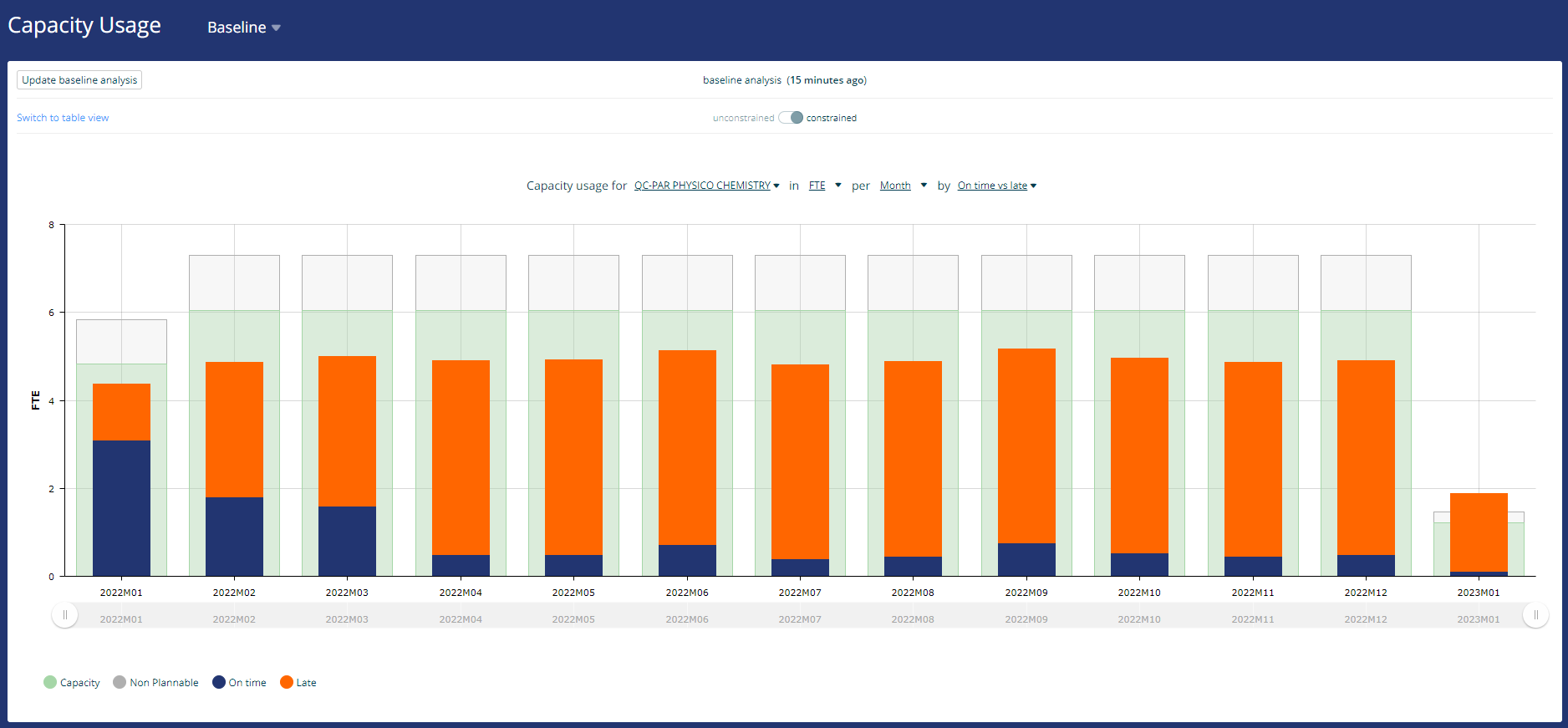
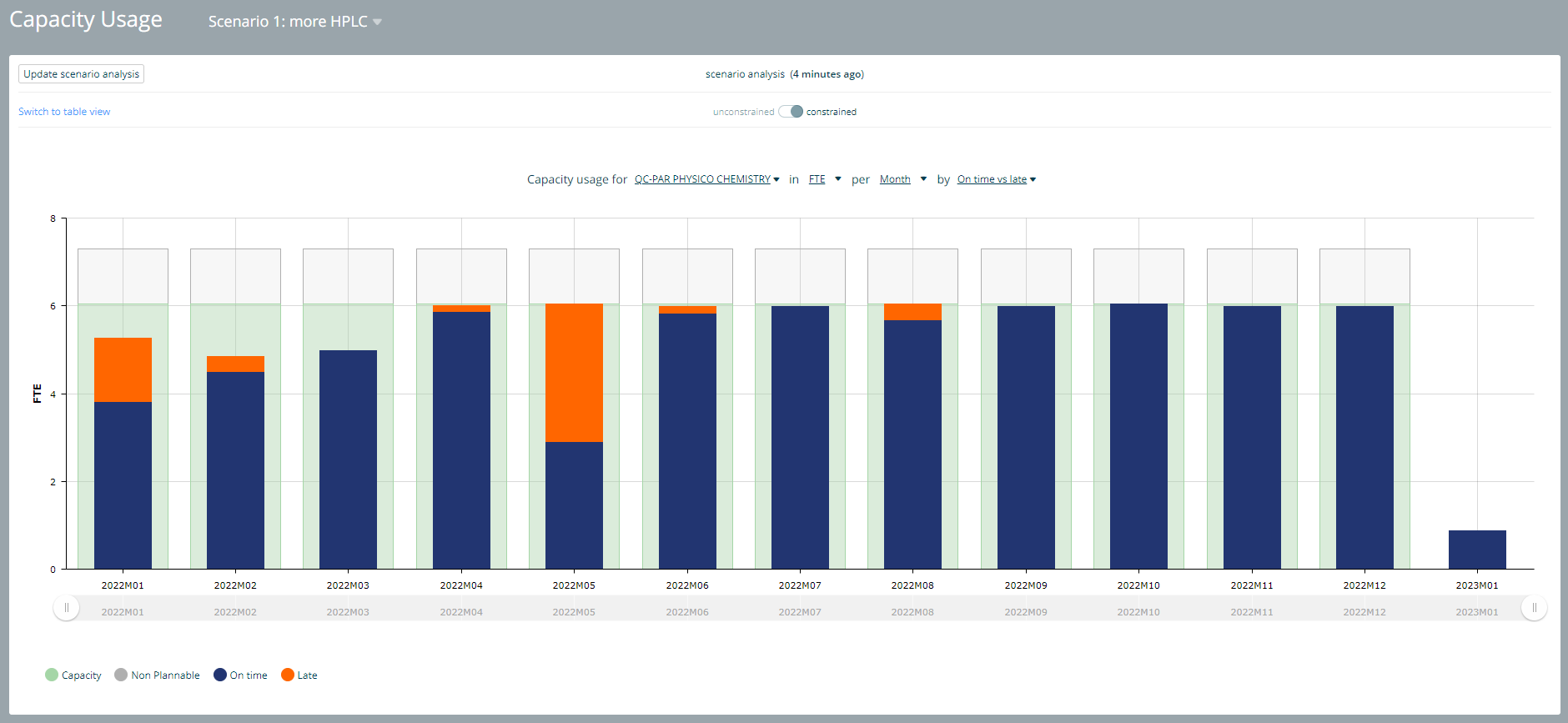
In this comparison between the Baseline and Scenario 1, you can clearly see that, by planning ahead and identifying a shortfall, your lab can make a relatively small investment in additional training to significantly improve on-time delivery over the coming year.
But what if your project has already started, is it too late to perform a WISA?
Timing and risk
To answer that question, let’s return to the original situation described above, only this time with a slight difference: as you approach the fork in the road, you notice a large stone tablet. Carved into its rocky surface is the following message:
CHOOSE CAREFULLY
ONE PATH LEADS TO THE LABORATORY
ONE PATH LEADS TO AN INESCAPABLE CREVASSE
This time, you are aware of the overall risk – either you will go home, or you will live the rest of your life in a hole – and you no doubt have a preference for one outcome over the other! However, according to multiverse theory, knowing the stakes doesn’t actually help you know which path is which: when you make your choice, you still have a 50:50 chance of picking the better option but, even once you have committed to the left path (and so objectively have a 100% chance of falling down the crevasse), you will not subjectively know which path you have taken until you are stuck in that hole.
Risk awareness
At least that’s in theory. In reality, of course, knowing what risks might lay ahead can give you vital clues about what to look for along the way. For instance, being aware of ice, loose rocks, or an unsteady footing could help you avoid disaster and allow you to retrace your steps back to the last known point of safety.
This highlights the importance of developing a clear and comprehensive risk assessment at the start of the planning phase, but also of maintaining an up-to-date risk register so that you can make informed decisions as new issues arise once the project is ongoing. For this reason, while the optimal time to conduct a WISA is before the project begins, it is also highly impactful at different stages throughout the project, especially when confronted with unplanned situations to which you must adapt.
Adapting your ‘what-if’ scenario, illustrated
Take, for example, an ongoing project that has been successfully running in your QC lab for the past 3 months. You know that a new project is planned to begin in just over a year and your Binocs capacity view shows that the proposed work is effectively leveled:
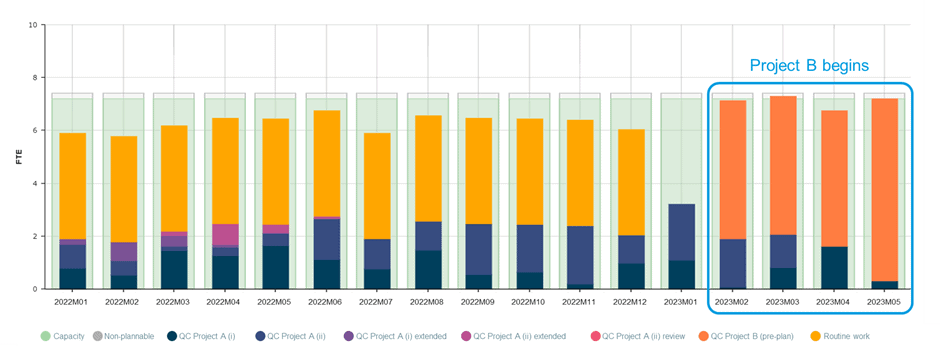
However, you have just been informed that the priority of the new project has been increased and it may need to be brought forward by a whole year! You can create a new Scenario in Binocs that asks the question “what if ‘QC Project B’ starts 12 months early?”:
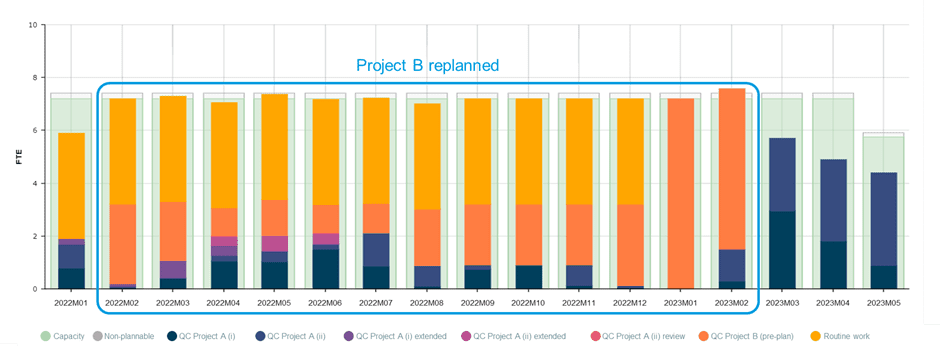
On the surface this looks like a seamless replanning of all the work required to complete both Projects A and B, however, by examining the ‘late vs on time’ analysis, it quickly becomes clear that the additional work will result in significant delays for critical project tasks:
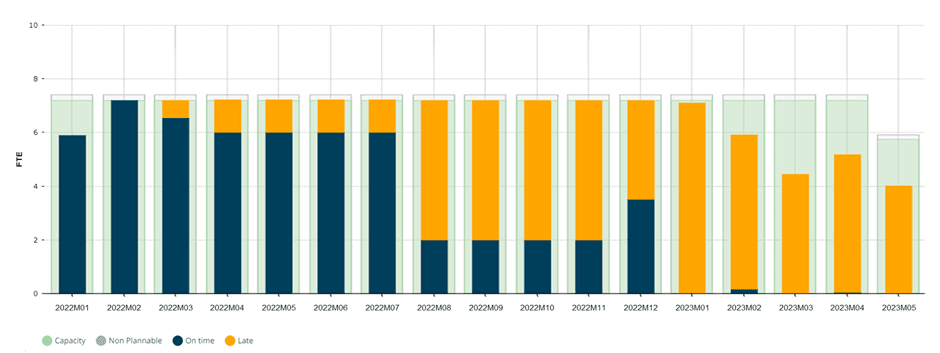
Exploring alternatives
Once again using the Binocs Scenario feature, you can create a new copy of the Scenario and begin to ask further questions in an attempt to find solutions to this capacity problem. One possible solution might be to increase the workforce in your team by subbing-in team members from another lab or by outsourcing some tasks to a contract agency – but how do you know the optimal spread of additional staff to effectively meet the demand?
One approach might be to run multiple scenarios that look at different resource allocations, for instance contrasting the impacts of adding 5 FTE over a period of 6 months against adding 6 FTE over a period of 4 months:
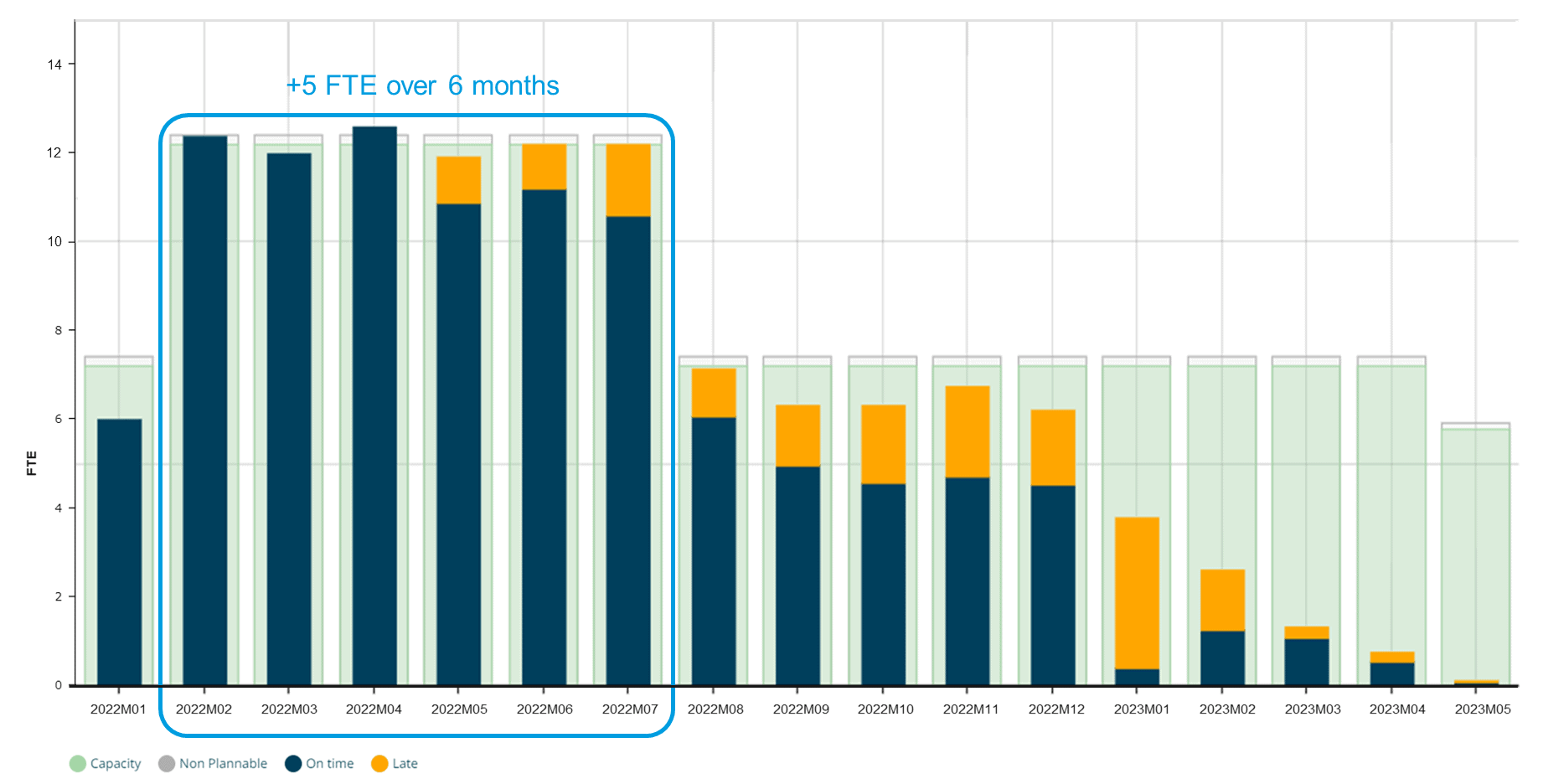
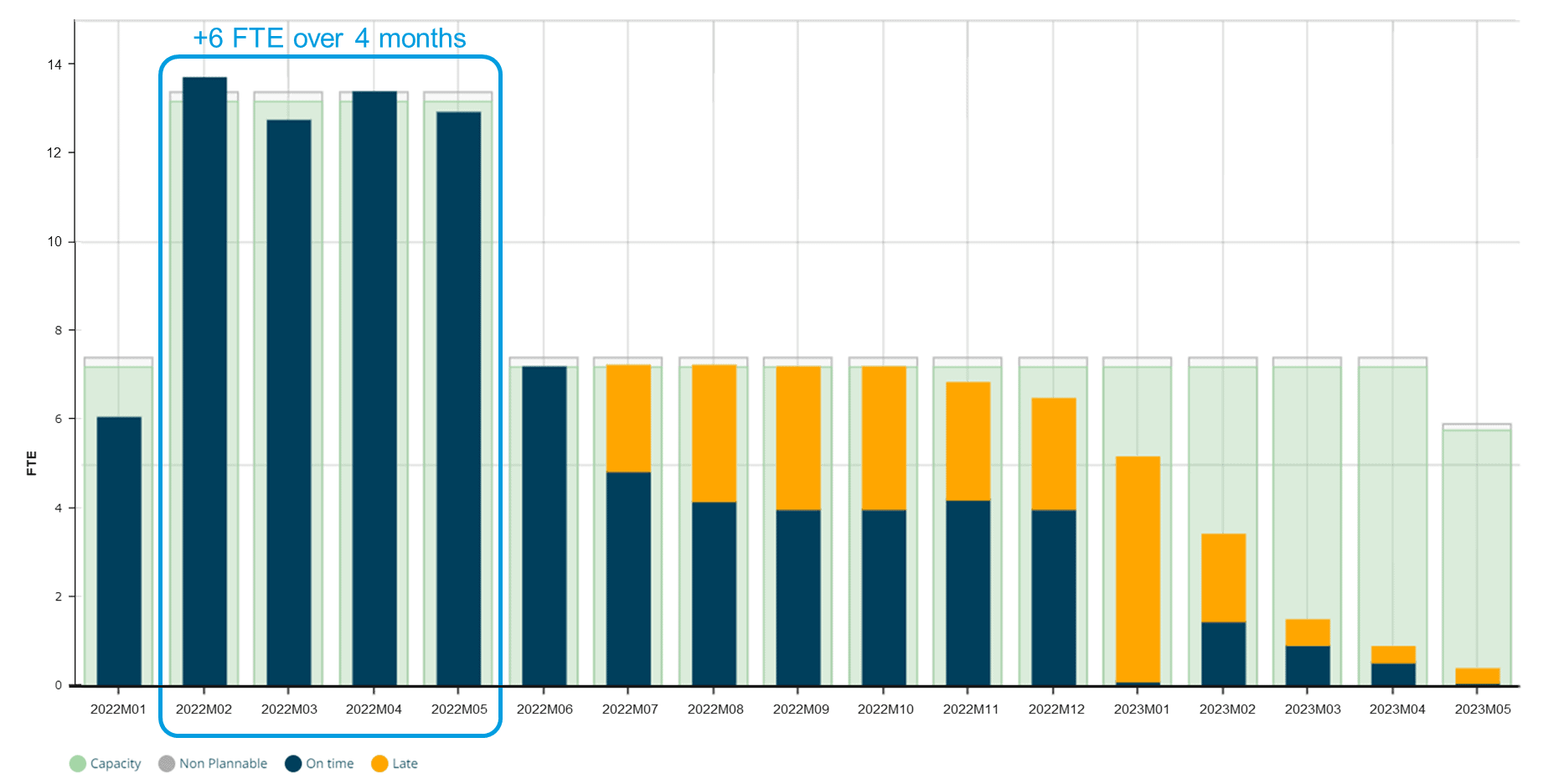
This comparison demonstrates that critical project tasks can be delivered on time in both scenarios and that similar outcomes can be achieved with a total increase of 24 FTE (6 FTE over 4 months) instead of 30 FTE (5 FTE over 6 months). And you don’t have to stop there – you can create as many scenarios as required to identify the best fit for your requirements. Indeed, some of our existing clients have produced literally thousands of scenarios exploring different ‘what-if’ case studies to optimize their capacity planning!
Many worlds lay before you and, as you decide how to move forward with your lab’s capacity planning solutions, you can be 100% certain that there are versions of you across the multiverse who have chosen to request a Binocs demo – so contact us today and avoid being stuck in a planning hole, asking yourself “what if I’d picked Binocs?!”



